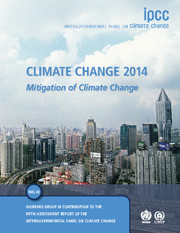 Climate Change 2014: Mitigation of Climate Change
Climate Change 2014: Mitigation of Climate Change Book contents
- Frontmatter
- Foreword, Preface, Dedication and In Memoriam
- Contents
- Summary for Policymakers
- Technical Summary
- Chapters
- Chapter 1 Introductory Chapter
- Chapter 2 Integrated Risk and Uncertainty Assessment of Climate Change Response Policies
- Chapter 3 Social, Economic, and Ethical Concepts and Methods
- Chapter 4 Sustainable Development and Equity
- Chapter 5 Drivers, Trends and Mitigation
- Chapter 6 Assessing Transformation Pathways
- Chapter 7 Energy Systems
- Chapter 8 Transport
- Chapter 9 Buildings
- Chapter 10 Industry
- Chapter 11 Agriculture, Forestry and Other Land Use (AFOLU)
- Chapter 12 Human Settlements, Infrastructure, and Spatial Planning
- Chapter 13 International Cooperation: Agreements & Instruments
- Chapter 14 Regional Development and Cooperation
- Chapter 15 National and Sub-national Policies and Institutions
- Chapter 16 Cross-cutting Investment and Finance Issues
- Annexes
- Index
Chapter 6 - Assessing Transformation Pathways
from Chapters
Published online by Cambridge University Press: 05 February 2015
- Frontmatter
- Foreword, Preface, Dedication and In Memoriam
- Contents
- Summary for Policymakers
- Technical Summary
- Chapters
- Chapter 1 Introductory Chapter
- Chapter 2 Integrated Risk and Uncertainty Assessment of Climate Change Response Policies
- Chapter 3 Social, Economic, and Ethical Concepts and Methods
- Chapter 4 Sustainable Development and Equity
- Chapter 5 Drivers, Trends and Mitigation
- Chapter 6 Assessing Transformation Pathways
- Chapter 7 Energy Systems
- Chapter 8 Transport
- Chapter 9 Buildings
- Chapter 10 Industry
- Chapter 11 Agriculture, Forestry and Other Land Use (AFOLU)
- Chapter 12 Human Settlements, Infrastructure, and Spatial Planning
- Chapter 13 International Cooperation: Agreements & Instruments
- Chapter 14 Regional Development and Cooperation
- Chapter 15 National and Sub-national Policies and Institutions
- Chapter 16 Cross-cutting Investment and Finance Issues
- Annexes
- Index
Summary
Introduction
6.1.1 Framing and evaluating transformation pathways
Stabilizing greenhouse gas (GHG) concentrations at any level will require deep reductions in GHG emissions. Net global CO2 emissions, in particular, must eventually be brought to or below zero. Emissions reductions of this magnitude will require large-scale transformations in human societies, from the way that we produce and consume energy to how we use the land surface. The more ambitious the stabilization goal, the more rapid this transformation must occur. A natural question in this context is what will be the transformation pathway toward stabilization; that is, how do we get from here to there?
The topic of this chapter is transformation pathways. The chapter is motivated primarily by three questions. First, what are the near-term and future choices that define transformation pathways including, for example, the goal itself, the emissions pathway to the goal, the technologies used for and sectors contributing to mitigation, the nature of international coordination, and mitigation policies? Second, what are the key decision making outcomes of different transformation pathways, including the magnitude and international distribution of economic costs and the implications for other policy objectives such as those associated with sustainable development? Third, how will actions taken today influence the options that might be available in the future?
Two concepts are particularly important for framing any answers to these questions. The first is that there is no single pathway to stabilization of GHG concentrations at any level. Instead, the literature elucidates a wide range of transformation pathways. Choices will govern which pathway is followed. These choices include, among other things, the long-term stabilization goal, the emissions pathway to meet that goal, the degree to which concentrations might temporarily overshoot the goal, the technologies that will be deployed to reduce emissions, the degree to which mitigation is coordinated across countries, the policy approaches used to achieve these goals within and across countries, the treatment of land use, and the manner in which mitigation is meshed with other policy objectives such as sustainable development.
- Type
- Chapter
- Information
- Climate Change 2014: Mitigation of Climate ChangeWorking Group III Contribution to the IPCC Fifth Assessment Report, pp. 413 - 510Publisher: Cambridge University PressPrint publication year: 2015
- 26
- Cited by

